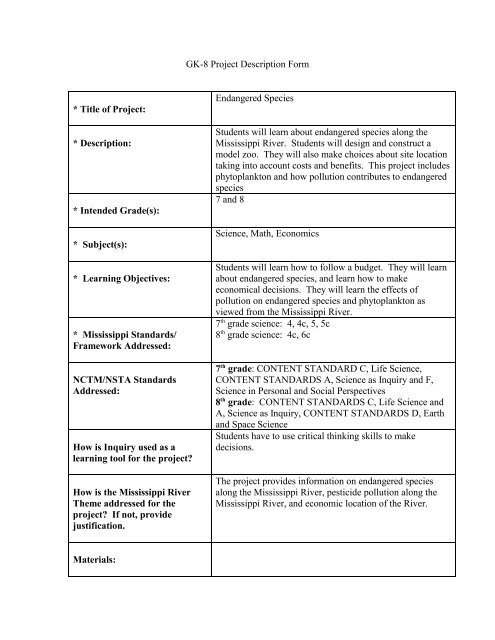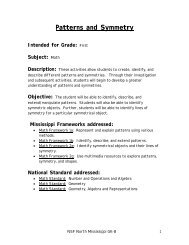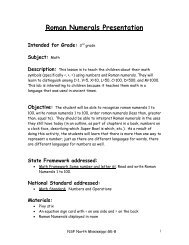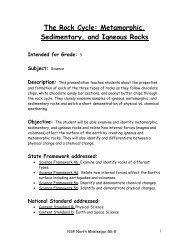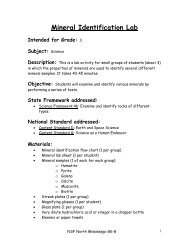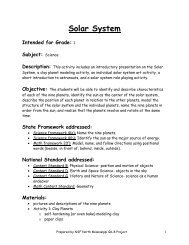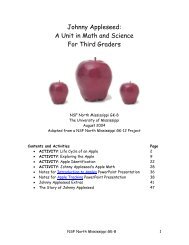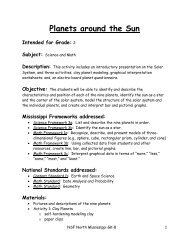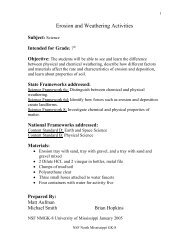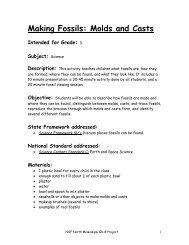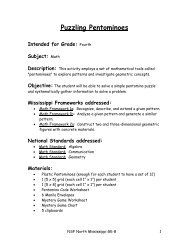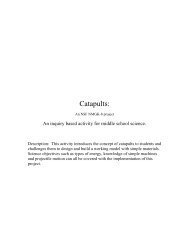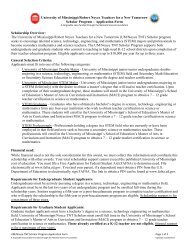ZOO CREATION AND SITE SELECTION
ZOO CREATION AND SITE SELECTION
ZOO CREATION AND SITE SELECTION
You also want an ePaper? Increase the reach of your titles
YUMPU automatically turns print PDFs into web optimized ePapers that Google loves.
GK-8 Project Description Form* Title of Project:* Description:* Intended Grade(s):* Subject(s):* Learning Objectives:* Mississippi Standards/Framework Addressed:NCTM/NSTA StandardsAddressed:How is Inquiry used as alearning tool for the project?How is the Mississippi RiverTheme addressed for theproject? If not, providejustification.Endangered SpeciesStudents will learn about endangered species along theMississippi River. Students will design and construct amodel zoo. They will also make choices about site locationtaking into account costs and benefits. This project includesphytoplankton and how pollution contributes to endangeredspecies7 and 8Science, Math, EconomicsStudents will learn how to follow a budget. They will learnabout endangered species, and learn how to makeeconomical decisions. They will learn the effects ofpollution on endangered species and phytoplankton asviewed from the Mississippi River.th7 grade science: 4, 4c, 5, 5cth8 grade science: 4c, 6cth7 grade: CONTENT ST<strong>AND</strong>ARD C, Life Science,CONTENT ST<strong>AND</strong>ARDS A, Science as Inquiry and F,Science in Personal and Social Perspectivesth8 grade: CONTENT ST<strong>AND</strong>ARDS C, Life Science andA, Science as Inquiry, CONTENT ST<strong>AND</strong>ARDS D, Earthand Space ScienceStudents have to use critical thinking skills to makedecisions.The project provides information on endangered speciesalong the Mississippi River, pesticide pollution along theMississippi River, and economic location of the River.Materials:
10. Give the groups 10 – 15 minutes to make their decision as to where to locate the zoo.11. Ask the group leader from each group to explain to the class where they chose tolocate the zoo and why. Give costs and benefits to their location.12. After each group has given their explanation, give the groups pages three and four.Have the groups again choose a site for the zoo based on the new stipulations. Give themabout 15 minutes to decide on the site location of the zoo. Remember that the design ofthe zoo cannot be altered (i.e., if the chosen design had the parking lot between theanimal exhibit and the water retention area, this cannot be changed).13. Round two will have your group locate the zoo on the land map provided, given thelist of constraints. Once you have determined the exact location of the zoo, be preparedto explain the reason that exact location was selected. Note in your explanation yourvalues as well as the relative costs and benefits you considered in making your locationchoice. In addition, discuss the differences in process and final result between roundsone and two.3
Zooconomy ProjectYou are about to enter Phase I of the Zooconomy Project. The choices you makenow will have lasting effects and will determine the future of your community. Goodluck!Phase I.A company wants to build a new zoo in your community. The budget allotted forthis project is $5.5 million. Your mission is to design a zoo model and to decide whichexhibits you will use in your model using the attached budget. You will only be able toexhibit some of the animals listed if you want to stay under budget. The base can only be24”X 18”, but note that shapes other than rectangles are allowed (as long as they fitwithin the 24”X 18”). To define the area of the zoo, a fence must be placed along theoutside borders of the zoo. The best design will be chosen to be used for the project.RubricA variety of animal exhibits under budgetParking lot of visitorsWater retention areaFood courtFenceCreativity15 pts15pts15 pts15 pts15 pts25 pts4
Zoo BudgetTotal Budget = $5.5 millionI. Structure: $1,925,000II. Startup Operational Costs: $825,000- food, utilities, etc.III. Parking lot: $550,000IV. Landscaping: $825,000V. Possible Exhibits*: $1,375,000 Gorilla – $200,000 Monkey- $100,000 Ape – $150,000 Orangutan – $100,000 Baboon – $100,000 Rhinoceros – $300,000 Elephant – $500,000 Giraffe – $100,000 Zebra – $75,000 Hippopotamus – $100,000 Meerkat – $25,000 Alligator – $10,000 Crocodile – $10,000 Tortoise – $5,000 Panda – $750,0005
Snake – $20,000 Insect – $2,000 Spider – $5,000 Bat – $5,000 Aquarium – $150,000 Farm Animals – $30,000 Lion – $50,000 Tiger – $50,000 Bear – $70,000 Leopard – $50,000 Jaguar – $40,000 Bird – $25,000 Seal – $30,000 Dolphin – $50,000 Whale – $75,000 Penguin – $25,000Please note that the amount listed next to each animal is how much an entireexhibit would cost.6
<strong>ZOO</strong> <strong>CREATION</strong> <strong>AND</strong> <strong>SITE</strong> <strong>SELECTION</strong> 1PHASE IIINTRODUCTIONLiving with relative scarcity is difficult. Decisions must be made that carry both relativecosts and benefits. Locating a zoo within a community is a major decision. People giventhe responsibility of locating a zoo must determine what is important and what theyvalue, then look at the costs and benefits to choose an appropriate site.SIMULATION PROCEDURETwo rounds will be conducted in this simulation.Round one will have your group locate the zoo on the land map provided. Once youhave determined the exact location of the zoo, be prepared to explain the reason thatexact location was selected. Note in your explanation your values as well as the relativecosts and benefits you considered in making your location choice.Round two will have your group locate the zoo on the land map provided, give the list ofconstraints. Once you have determined the exact location of the zoo, be prepared toexplain the reason that exact location was selected. Note in your explanation your valuesas well as the relative costs and benefits you considered in making your location choice.In addition, discuss the differences in process and final result between rounds one andtwo.OBJECTIVESStudents will use economics to develop analytical and critical thinking skillsStudents will learn, through research, the role that zoos play in helpingendangered animalsStudents will analyze the different arguments on the instruction/rubric sheet andmake decisions concerning costs and benefitsStudents will learn which animals are endangered and what causes these animalsto be placed on the endangered listsStudents will come to the conclusion that people value things differently17
INSTRUCTIONS FOR THE <strong>ZOO</strong> SITING COMMITTEE?You are to decide on an appropriate site for a new zoo to be built in a town.?The town currently has a very large population of students, elementary throughcollege.?Mr. Gotpets owns Oxford Industries, a 400 employee manufacturer of OxfordClothes. Oxford Industries is currently located in New York, but Gotpets hatesthe cold, as do most of his employees. His parents also live in our town.?Last year, Mr. Gotpets decided to move Oxford Industries into our town. Threehundred of his loyal employees and their families have chosen to move with OI.This will create 100 new jobs in our town.?Most of the employees are paid lower to average wages, and many have youngchildren.? The nearest zoo is currently over 200 miles away. It is close to capacity. Localparents have been complaining about the long drive to visit the educational andfun zoo.?When Susie Investor heard about the contemplation of a zoo, she purchased a largetrack of land on which to build a new subdivision. In lieu of paying the impactfee for the zoo, the Zoo Board agreed to accept Ms. Investor’s donation of a trackof land. (See attached map)?The zoo will complete construction of their new facility in 18 months, and willmove in immediately after construction. Ms. Investor will have her subdivisioncomplete by that time too. She has already put in the infrastructure and has begunconstruction of the homes closest to the zoo site.?The average time for construction of the new zoo is 14 months. Your zoo districthas only $5.5 million to build the zoo, which is a copy of a prototype zoo. Theprototype zoo cost $5.5 million to build, too; therefore, there is no money in thebudget for unexpected contingencies.?The zoologists in the district, who are already underpaid, are only budgeted for a 3%raise this year, which is approximately $500,000.?The town in which the zoo is being built will have a population that includes 15%Native Americans.?The Town Council promised Mr. Gotpets that if he moved to our town, the townwould ensure that there would be adequate housing and that his employees’children would go to the zoo in our town. Mr. Gotpets is threatening to move hisfactory to another town if the zoo is not ready when his employees arrive.?You have been given a footprint of the prototype zoo. You are to place it on thedonated site in the most appropriate place. The entire circle must fit on the site,not just the square and small circle. For example, if any part of the large circletouches the trees, those trees must be removed.?Within your committee, you are then to choose a person to present your preferredsite location and reasoning to the entire group.Good Luck!8
ROLES IN THE TOWN MEETINGROLE:LINES:ROLE:LINES:ROLE:YOU ARE AN EXTREME ANIMAL HATERI don’t see why we have to build a zoo here at all. The real problem withThis world is the overpopulation of animals. There is no room left on theplanet for the cars and houses. And we certainly don’t need any moreanimals stinking up this town. Who cares about them anyway? Instead ofwasting our resources on an impractical endeavor, such as this crazed zooidea, we should be focusing our energy on expanding the town’s shoppingcomplexes complete with huge parking garages.YOU ARE A 70 YEAR OLD WOMANMy great-grandmother and great-grandfather met in this town. TheirInitials are carved in that old oak tree by the lake in the hunting grounds.My friends have started a petition drive and we already have 400signatures. So don’t think for a minute that you will touch one leaf on anyof those trees, or we’ll be picketing your homes.YOU ARE A YOUNG MOTHER WITH 3 SMALL CHILDRENLINES: Driving over 200 miles with three small children is a difficult feat. Yet azoo is an irreplaceable experience for a child, but by the time we finally get to the zoo,my children are already exhausted. My children should be able to have the sameeducational opportunities as every other child in the big cities. Our children should beable to see how tall a giraffe actually is, hear the lions roar, and watch the uniquecharacteristics of the gorilla. (tearfully) For our children, please bring us the zoo.ROLE:LINES:ROLE:LINES:NATIVE AMERICANI am Chief Joseph. We were here long before many of you. Some of theStudents who will be visiting the zoo are Native Americans, and we mustShow them that we value their heritage. You must not disturb this sacredPlace.IRRATIONAL PERSON(yelling) Zoos teach too much animal education. We don’t need any moreeducation in this country. It’s what’s wrong with this country now. MTV,Broken families. Get rid of animals! !ROLE:<strong>ZOO</strong>LOGIST9
L<strong>AND</strong> USE <strong>SITE</strong> <strong>SELECTION</strong> SIMULATIONDESCRIPTION OF CURRENT L<strong>AND</strong> USE/REGULATIONSI. ENDANGERED SPECIES HABITATThe Mississippi Redbelly Turtles are protected species. Sections of this area are nestingsites for the Mississippi Redbelly Turtle and the Gopher Tortoise. This unique locationprovides excellent feeding, resting and wintering habitat for numerous types of migratorybird species. Gopher tortoises are protected species because they burrow under theground, and their burrows house over 100 endangered species. It is permissible torelocate the gopher tortoises and the turtles; however, one must either have to wait for 30days to try to trap the gopher tortoise and find new land on which to place them, or digthem out. There are approximately 100 gopher tortoises and 100 Mississippi redbellyturtles on this location. (The cost for digging out one turtle or tortoise recently was$2100 because construction was not able to be delayed for 30 days.) In addition, onemust have land on which to relocate the gopher tortoises and the turtles. The governmentis in the process of proposing new regulations to prevent the relocation because thetortoises are showing up with and AIDS - like illness to their immune system.II.DEER HUNTING AREAThis hunting area is a major sporting activity for the people in the town. Also in this areaare many trees and lakes that members of the community have strong affinities toward.Disturbing this area would create tension within the community.III.CATFISH PONDThe catfish pond is a major source of income for the town. It provides revenue and jobsfor the town. Currently 40 employees are employed by the catfish farming business inthe town.IV.NATCHEZ TRACEThe 444-mile Natchez Trace Parkway commemorates an ancient trail that connectedsouthern portions of the Mississippi River to salt licks in today’s central Tennessee. Overthe centuries, the Choctaw, Chickasaw and other American Indians have left their markon the Trace. The Natchez Trace experienced its heaviest use from 1785 to 1820 by the“Kaintuck” boatmen that floated the Ohio and Miss. Rivers to markets in Natchez andNew Orleans. They sold their cargo and boats and began the trek back north on foot toNashville and points beyond. Today, visitors can experience this All-American Roadthrough hiking, biking, horseback riding and camping. Cutting into this area is14
unacceptable to many people. This location is the pride of the state and is used as a townmeeting area.V. HAZARDOUS WASTE AREAUnder federal law, the owner or operator of the site is responsible for removing thehazardous waste and restoring the site to its original condition. The average “Superfund”site costs $20 million to restore. The delay for clean-up could be up to 10 years. In thiscase, we do not know who caused the dumping, so the zoo district, as owner, could beheld responsible.VI.INDIAN BURIAL GROUNDThis is a very sensitive issue with the Native American population in the town.VII.SCHOOLThe school is the only school in the town for grades K-12. This school can only beremoved if a new one is provided for the town. The current cost for a new school is $4million.VIII.POTENTIAL ACCESS OVER MISSISSIPPI RIVERThe cost to build a bridge over the MS River is between $1,000,000 and $1,500,000.This is obviously a major river throughout the state, and the state has refused to requestto build the bridge. It would have to be funded through the zoo.15
How Extinction HappensPlants and animals can disappear because of changes to the earth that are caused either bynature or by the actions of people. Sometimes a natural event, like a volcano erupting,can kill an entire species. Other times, extinction will happen slowly as nature changesour world. For example, after the Ice Ages, when the great glaciers melted and the earthbecame warmer, many species died because they could not live in a warmer climate.Newer species that could survive a warmer environment took their places.People can also cause the extinction of plants and animals. The main reason that manyspecies are endangered or threatened is because people have changed the homes orhabitats upon which these species depend. A habitat includes not only the other plantsand animals in an area, but all of the things needed for the species' survival - fromsunlight and wind to food and shelter. The United States has many habitats, from oceanbeaches to mountaintops. Every species requires a certain habitat in order to live. Acactus, for example, needs the sunny, dry desert in order to grow. A polar bear, on theother hand, would not live in a desert, because it could not find enough food and water.Pollution can also affect wildlife and contribute to extinction. The Nashville crayfish isendangered mainly because the creek where it lives has been polluted by people livingnearby. Pesticides and other chemicals can poison plants and animals if they are not usedcorrectly. The bald eagle is one bird that was harmed by pesticides. In the past, apesticide called DDT was used by many farmers. Rains washed the pesticide into thelakes and streams where it poisoned fish. After eating the poisoned fish, the eagleswould lay eggs with very thin shells. These eggs were usually crushed before they couldhatch. Today, people are not allowed to use DDT, and the bald eagle, although stillendangered, has slowly begun to increase in number.People can also endanger plants and animals by moving, or introducing, new species intoareas where they do not naturally live. Some of these species do so well in their newhabitat that they endanger those species already living there, called the native species.For example, when some fish are introduced into a lake or stream, they may prey upon,or eat the food of the native fish. The native species may then have to find a new sourceof food or a new home, or face becoming endangered or extinct. A recent pest that hascome to Iowa is the Zebra Mussel. It is a small clam animal that came to the Great Lakesof North America in ballast water of ships that came from eastern Europe. The ZebraMussel is now in the Mississippi River and is a threat to our native species.Another way that people harm animals and plants is by taking them from the wild. Somepeople might catch an insect like the Mission Blue Butterfly for a butterflycollection. Others might capture a wild animal for a pet, or pick a flower because it'spretty. In addition, some people illegally hunt animals for food, skins, or fur. In the past,many American crocodiles were killed so that their skins could be made into shoes andother clothing. Now the American crocodile is an endangered species.16
Activity One:Have students collect articles found in a newspaper or magazine regarding anenvironmental issue (water quality, industrial run-off, threatened or endangered species).Include in their comments, the importance or significance of the event on their localcommunity. Optional activity: students can submit a report or give a Power Pointpresentation to the class.Activity Two:Students can organize a portfolio identifying a threatened or endangered species foundalong the Mississippi River. The students should provide a map to locate the organism’shabitat, several local rivers or tributaries,The portfolio should be evaluated on the following:Understanding of an environmental issueAn appreciation of the environment of the riverMastery of a variety of writing skillsEndangered Organisms of the Mississippi RiverZebra musselPeregrine falconBlue HeronTopeka shinerBrown PelicanRed shouldered hawkGolden EagleActivity Three:Have students create a food chain with the raptor or peregrine being the top predator.17
Endangered Species Due to Pesticide Pollution: A Study of the Mississippi RiverGK-8 Middle School TeamFunded by the National Science Foundation18
Endangered Species Due to Pesticide Pollution: A Study of the Mississippi RiverBackgroundPeregrine falcons were listed as endangered under the Endangered Species Act of 1973.Although never that abundant as breeding birds in the continental United States, thepopulation went into a nose-dive beginning in the late 1940s. By the mid-1960s nestingpopulations had been eliminated east of the Mississippi River. Western populations werereduced by up to 90%. Scientists investigating the decline found very high concentrationsof the pesticide DDT and its by-products in their tissues. Because they fed on birds, manyof which ate insects, peregrines received a mega-dose due to bioaccumulation of DDTand its residues up the food chain. The chemicals interfered with calcium deposition ontheir eggs, which failed to hatch. Illegal shooting, collisions with man-made objects, andegg and chick collection also impacted populations, but none of these compared with thedrastic effects of pesticides. DDT was banned for usage in North America in 1972, andcoupled with protection under the ESA and captive reintroduction efforts, thesemagnificent birds began to recover. In 1984, the tundra subspecies was downgraded tothreatened status, and by the mid-1990s populations of American peregrine falcons beganto approach the recovery goals that were set when they were listed. They were delisted inAugust 1999. They may even exceed historical levels here in the Northwest, as humanrelated changes have resulted in more open space, which provides suitable foraginghabitat for these falcons.Humans need raptors (birds of prey). Here are only a few of the benefits raptors provide:Raptors help keep animal populations in balance.Raptors consume many animals that humans consider as pests, including mice,rats and destructive species of insects. This helps to control disease and damageto crops.As top predators of their food chain, raptors are an indicator species of the overallhealth of the ecosystem in which they live.Of equal importance, witnessing wild raptors enriches each of our lives. Imaginewhat life would be like if we could no longer gaze upon the grandeur of raptorssoaring high above.Provided by the Woodland Park Zoological Society (peregrinefund.org)19
Raptor FAQQ: What is the difference between "raptors" and "birds of prey."A: Both terms may be used inter-changeably for hawks, owls, eagles and falcons.Q: What raptors are extinct or on the Endangered Species List?A: In North America the bald eagle and peregrine falcon were placed on the EndangeredSpecies list but both are being considered for removal. The peregrine falcon populationfound east of the Mississippi River is considered to have gone extinct and has since beenre-established with breeding stock including a variety of sub-species of the peregrinefalcon.Q: Why has the peregrine falcon made such a comeback?A: The most important reason is the ban on most uses of DDT. Protection from shootingunder the Endangered Species Act was important along with education about birds ofprey and captive breeding that provided young birds to accelerate the populationrecovery.Q: How much food does a peregrine falcon eat in a day?A: A peregrine eats the equivalent of one quail-sized bird per day. We have documentedthe remains of more than 200 different species of prey in peregrine falcon nests. On agiven day peregrine falcon might eat most of a pigeon, or part of a duck or two or moresparrow sized birds to meet its nutritional needs.Q: Which species are the most successful hunters?A: All raptor species are pretty much equally successful. In fact, you could say that eachraptor species does what it does better than any other bird on the continent.Q: How do you go about repairing thin eggshells?A: We cannot repair thin-shelled eggs. The biggest problem with thin-shelled eggsbeyond being extremely fragile, is their tendency to lose moisture too fast duringincubation. We found that we could incubate them in a very "wet" incubator to preventthe embryo from drying out and dying. Sometimes we coated a portion of the eggshellwith wax to help it retain moisture.Q: What other animals live in the peregrine falcon's habitat?A: The peregrine falcon lives primarily in the vertical environment of the sky and restsupon high places on the landscape that overlook vast gulfs of air including cliff ledges,skyscrapers, and bridges. Since they spend most of their time in the sky above all thecontinents of the world except Antarctica, they are likely to encounter an extremely widerange of bird species, as well as a few mammalian and reptilian species that make theirhomes among the rugged cliff faces of the world.20
Q: Where do birds of prey like to nest?A: Each species of predatory bird chooses a nest site where it can easily reach food tofeed its young. The peregrine falcon scrapes a depression on a cliff ledge. The goldeneagle builds a stick nest in an oak, sycamore or other tree in open country where it canhunt ground squirrels and rabbits. They also use cliff ledges. Harriers nest in a thicket ofbrush right on the ground in the midst of good mousing habitat, and so on. Check a fieldguide for each species.Q: Do farmers still kill golden eagles?A: As recently as twenty years ago it was very common for golden eagles to be shotbecause ranchers thought they often killed lambs. Through education and awareness thepractice of indiscriminately shooting eagles has largely been abandoned. However,poison baits intended for other predators kill many eagles every year incidentally. (In1996 the U. S. Department of Agriculture Wildlife Services program, spent $20 millionto kill 80,000 coyotes, 7,000 foxes, 1700 bobcats, 300 black bears, and 250 mountainlions in the 17 western states. Predator Project. (Facts provided by Santa Cruz ResearchPredatory Group)21
Design a phytoplankerPhytoplankton are microscopic organisms that live in aquatic ecosystems and have thebiological pigments necessary for photosynthesis. There are many different types ofphytoplankton of myriad shapes. With only a few exceptions, these unicellular orcolonial organisms are more dense than water. Therefore, in the absence of upwellingsor other water currents that might keep them afloat, they will eventually sink in the waterand land down in the sediments. For photosynthetic organisms that require energy fromthe sun, this is an issue. The shapes of phytoplankton are so varied that phycologistsspeculate that some of these diverse shapes might increase resistance to sinking.Materials:1 liter graduated cylinder (one per group)Plasticine clay (Playdough)Wet-dry erase markerMaple syrupCanola oilVegetable oilBalancePre-class preparationActivity One:1. Mark a 1 liter graduated cylinder ( 500 ml and 250 ml graduated cylinder may besubstituted) with a wet-dry erase marker; place a mark 10 cm and 20 cm from thetop of the graduated cylinder.2. Fill a 1 liter graduated cylinder with corn syrup. This should be done for eachgroup3. Weigh out 3 grams of plasticine clay on a balance. Note that each group willreceive 9 clay models for the first three activities.Activity Two:1. Mark a 1 liter graduated cylinder ( 500 ml and 250 ml graduatedcylinder may be substituted) with a wet-dry erase marker; place amark 10 cm and 20 cm from the top of the graduated cylinder.2. Fill a 1 liter graduated cylinder with vegetable or canola oil. This should be donefor each group. Suggestion: The maple syrup can be placed into originalcontainer and replaced with vegetable or canola oil.22
Activity Three:1. Mark a 1 liter graduated cylinder ( 500 ml and 250 ml graduatedcylinder may be substituted) with a wet-dry erase marker; place amark 10 cm and 20 cm from the top of the graduated cylinder.2. Fill a 1 liter graduated cylinder with turbid stream or pond water. This should bedone for each group. Suggestion: The vegetable oil can be placed into originalcontainer and replaced with pond or stream water.In class discussion:Give a definition of phytoplankton to students.List their role in an aquatic food chain.Describe several shapes of phytoplankton (see handout)List the trophic levels in a food chain (consumer, producer, decomposer)Compare individuals in an aquatic and terrestrial food chainTeacher Notes:Discuss the importance of phytoplankton:Phytoplankton are small microscopic plants which are positioned at the bottom of aquaticfood chains. Additionally, phytoplankton are photosynthetic and provide most of theoxygen that we breathe. As phytoplankton reproduce and multiply, they are eaten bysmall fish which serve as food for larger fish.Phtoplankton can only survive at the photic level of the ocean. The photic layer is theocean depth to which light can penetrate to facilitate photosynthesis. Size is one way toclassify phytoplankton. Phytoplankton range in size from 0.2 m-200m.Discuss the importance of light to phytoplankton:Phytoplankon are photosynthetic organisms (require light to produce energy). They can23
only survive at the photic level of the ocean. The photic layer is located close to thewater surface so light can penetrate to facilitate photosynthesis.Discuss the importance of size, turbidity (water clarity) and density tophytoplankton sedimentation rates:SizeSmall particles will sink more slowly than large particleTurbidity High sediment (debris, particle) concentration (high turbidity) results in slowersedimentation rateDensity Low density objects results in slower sedimentation ratesForm resistance -- certain shapes tend to settle slowly. Spines and certain colony shapescan help this (C.S. Reynolds)Reynolds, C.S. 1984. The Ecology of Freshwater Phytoplankton Cambride UniversityPress, New York.Discuss the importance of nutrient availability to phytoplankton populations:In the open ocean, detritus and debris can settle out of the reach of the photic zone. Whenthis happens, their nutrients become unavailable to organisms at the surface. Thusnutrient availability is often limiting for marine phytoplankton. However, manyphytoplankton can survive during periods of nutrient depletion due to adaptations forcapturing nutrients. In certain areas, upwelling brings bottom waters and their dissolvednutrients to the water surface causing rapid growth under conditions of nutrientenrichment. Excess nitrogen levels are available to produce phytoplankton "blooms" tohigh densities, clouding and coloring the water with their profusion. Chronic conditionscan cause an overgrowth of phytoplankton resulting in a reduction of light reaching theocean’s bottom consequences for the rest of the ecosystem including reducing theamount of light reaching the bottom and decreasing the amount of oxygen duringphytoplankton respiration and decomposition.Discuss how zebra mussels, bighead carp and silver carp can remove phytoplanktonwhich disrupts food chains. Disruption may lead to endangered species.24
Zebra mussels (Dreissona polymorpha) disrupt the aquatic food chain by removingnearly all the phytoplankton and zooplankton from the ecosystem, which are in turn afood source for small fish that are the food source for larger fish like the walleye andtrout. Zebra mussels can attach themselves to the lakes and just about anything thatcomes in contact with them. Other species which disrupt the food chain by removingsignificant amounts of phytoplankton include mudsnails and the round goby.Bighead and silver carp are native Chinese species that were introduced to theMississippi and Missouri River in the early nineties. Both species can reach weights thatexceed fifty pounds. As phytoplankton and zooplankton feeders, bighead and silver carphave the potential to significantly disrupt the food web of the Mississippi Riverecosystem. These fish can eat up to 40% of their body weight everyday in phytoplankton.Also threatened is the commercial fishing industry, as invading these Asian carp clogfishing nets and scare away commercial catch.Define viscosity:Viscosity is a measure of the "thickness" of the liquid. It is an internal property thatoffers resistance to flow. Molasses and motor oil are thick or high viscous liquids.Gasoline and water are thin, low viscosity liquids. There are many ways to measureviscosity, including attaching a torque wrench to a paddle and twisting it in a fluid, usinga spring to push a rod into a fluid, and seeing how fast a fluid pours through a hole. Thisexperiment will measure how fast a sphere falls through a fluid. The faster a sphere falls,the lower the viscosity. This makes sense: if the fluid has a high viscosity it stronglyresists flow, so the sphere falls slowly. If the fluid has a low viscosity, it offers lessresistance to flow, so the sphere falls faster (Hawaii Institute of Geophysics andPlanetology).25
Activity OneGroup #__________Group Members:________________________________________________________________________________________________________1. Form plasticine (Playdough) clay into various phytoplankton shapes (seehandout); Make at least three models. Note that one shape should be spherical(shaped like a ball). Predict which shape will settle first, second, and third.2. Place the phytoplankton clay model in the graduated cylinder and record the timethat the model travels 10 cm and 20 cm with a stopwatch.Shape #1 10 cm time=______ 20 cm time______Shape #2 10 cm time=______ 20 cm time______Shape #3 10 cm time=______ 20 cm time______3. Record the mean and range for each distance10 cm 20 cmMean__________ Mean________Mode__________ Mode________4. Convert 10 cm and 20 cm into mm.10 cm= ______mm20 cm=_______mm26
Activity TwoGroup #__________Group Members:________________________________________________________________________________________________________1. Form plasticine (Playdough) clay into various phytoplankton shapes (seehandout); Make at least three models. Make sure that one shape is spherical(shaped like a ball). Predict which shape will settle first, second, and third.2. Place the phytoplankton clay model in the graduated cylinder and record the timethat the model travels 10 cm and 20 cm with a stopwatch.Shape #1 10 cm time=______ 20 cm time______Shape #2 10 cm time=______ 20 cm time______Shape #3 10 cm time=______ 20 cm time______3. Record the mean and range for each distance.10 cm 20 cmMean__________ Mean________Mode__________ Mode________4. Compare the results to activity one. Did the clay models settlefaster or slower? Why??? Please explain._______________________________________________________________________‘27
Activity ThreeGroup #__________Group Members:________________________________________________________________________________________________________1. Form plasticine (Playdough) clay into various phytoplankton shapes (seehandout); Make at least three models. Make sure that one shape is spherical(shaped like a ball). Predict which shape will settle first, second, and third.2. Place the phytoplankton clay model in the graduated cylinder and record the timethat the model travels 10 cm and 20 cm with a stopwatch.Shape #1 10 cm time=______ 20 cm time______Shape #2 10 cm time=______ 20 cm time______Shape #3 10 cm time=______ 20 cm time______3. Record the mean and range for each distance.10 cm 20 cmMean__________ Mean________Mode__________ Mode________4. Compare the results to activity one and two. Did the clay models settle faster orslower? Why??? Pleaseexplain.____________________________________________________________________________________________________‘28
Concluding The Lesson1. Have students compare and summarize their results and observations. Make afinal tally for the class and calculate the mean, mode, and range.2. Have students generate an aquatic and terrestrial food chain. Identify theproducers, primary consumers, secondary consumers, and tertiary consumers.What happens to energy as it passes through a food chain?29


